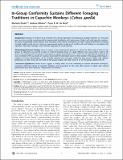In-group conformity sustains different foraging traditions in capuchin monkeys (Cebus apella)
Abstract
Background: Decades of research have revealed rich cultural repertoires encompassing multiple traditions in wild great apes, a picture crucially complemented by experimental simulations with captive apes. Studies with wild capuchin monkeys, the most encephalized simian species, have indicated a New World convergence on these cultural phenomena, involving multiple traditions and tool use. However, experimental studies to date are in conflict with such findings in concluding that capuchins, like other monkeys, show minimal capacities for social learning. Methodology/Principal Findings: Here we report a new experimental approach in which the alpha male of each of two groups of capuchins was trained to open an artificial foraging device in a quite different way, using either a slide or lift action, then reunited with his group. In each group a majority of monkeys, 8 of 11 and 13 of 14, subsequently mastered the task. Seventeen of the successful 21 monkeys discovered the alternative action to that seeded in the group, performing it a median of 4 times. Nevertheless, all 21 primarily adopted the technique seeded by their group's alpha male. Median proportions of slide versus lift were 0.96 for the group seeded with slide versus 0. 01 for the group seeded with lift. Conclusions/Significance: These results suggest a striking effect of social conformity in learned behavioral techniques, consistent with field reports of capuchin traditions and convergent on the only other species in which such cultural phenomena have been reported, chimpanzees and humans.
Citation
Dindo , M , Whiten , A & de Waal , F B M 2009 , ' In-group conformity sustains different foraging traditions in capuchin monkeys (Cebus apella) ' , PLoS ONE , vol. 4 , no. 11 , e7858 . https://doi.org/10.1371/journal.pone.0007858
Publication
PLoS ONE
Status
Peer reviewed
ISSN
1932-6203Type
Journal article
Description
Research was supported by a grant IOS-0718010 from the National Science Foundation to the senior author and the basegrant from the National Institutes of Health (RR-00165) to the Yerkes National Primate Research Center, and a Royal Society Leverhulme Trust Senior Fellowship to AW. The funders had no role in study design, data collection and analysis, decision to publish, or preparation of the manuscript.Collections
Items in the St Andrews Research Repository are protected by copyright, with all rights reserved, unless otherwise indicated.

